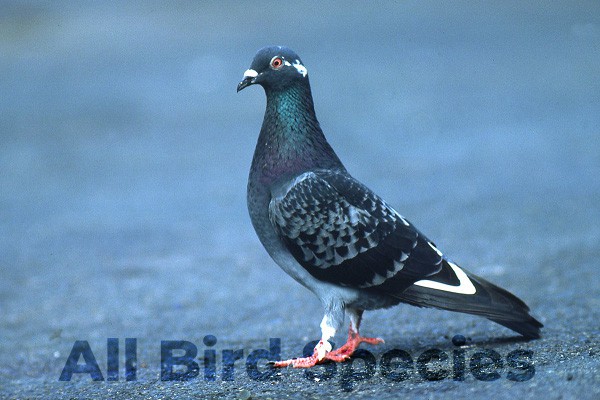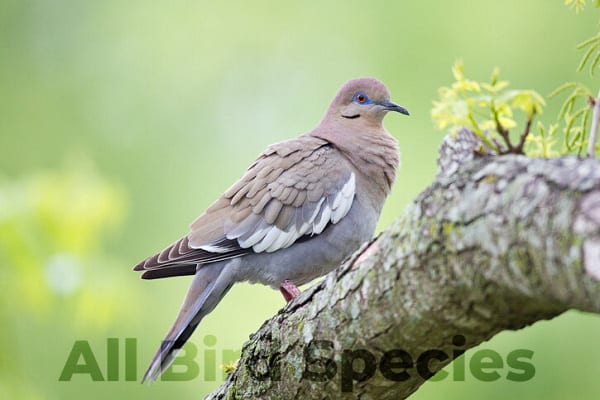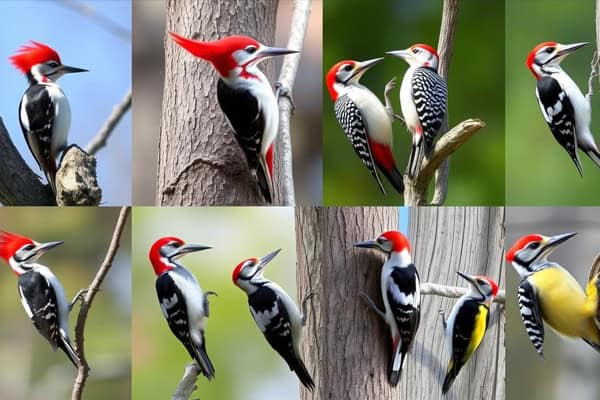4 Types of Doves (Pigeons) That Live in Kansas (With Pictures)
In this article we guide will help you learn about the doves and pigeons in Kansas. You’ll discover their unique traits, where they live, and how they behave. With pictures to help you identify them, you’ll see how diverse and important these birds are to our local wildlife.
Common Dove Species in Kansas
Kansas is home to many dove species, like the Mourning Dove and the Rock Pigeon. Knowing about these birds helps us appreciate local wildlife. Each species has special traits and habits that are important for the environment and hunting.
| Species | Habitat | Averge Lifespan | Diet | Unique Characteristic |
|---|---|---|---|---|
| Mourning Dove | Open or semi-open lands | 2 to 4 years (up to 15 years) | 98% seeds, >50% agricultural crops | Distinctive cooing call |
| Rock Pigeon | Urban areas, ledges, hillsides | Up to 6 years | Seeds, human food scraps | Highly adaptable to urban environments |
1. Mourning Dove
- Scientific Name: Zenaida macroura
- Size: 23–33 cm (9–13 in)
- Weight: 100–170 g (3.5–6.0 oz)
- Lifespan: Up to 5 years in the wild (can live longer in captivity)
- Diet: Primarily seeds, grains, and some fruits.
The Mourning Dove, known as Zenaida macroura, is a common bird in Kansas. Knowing about their looks, where they live, and how they breed is interesting. This info helps us enjoy these birds in Kansas skies.

Identifying Characteristics of the Mourning Dove
The Mourning Dove is known for its long tail and soft grayish-brown feathers. Their soft cooing sounds make them loved by birdwatchers. These doves look subtle yet beautiful, with shiny wings in the right light.
Habitat Preferences
Mourning Doves like open places like grasslands and farmlands. They also like urban areas with trees or power lines. Kansas’s varied landscapes offer them food and places to nest.
Breeding and Nesting Habits
In breeding season, Mourning Doves build nests in hidden spots. They use twigs and grasses for safety. They lay two eggs that hatch in about two weeks. This lets females have many broods, making them common in Kansas.
| Characteristic | Description |
|---|---|
| Scientific Name | Zenaida macroura |
| Coloration | Soft grayish-brown feathers |
| Tail | Long pointed tail |
| Habitat | Open areas such as grasslands and farmlands |
| Nesting Material | Twigs and grasses |
| Eggs Laid | Typically two |
| Incubation Period | About two weeks |
Must Read: Doves in Arizona
2. Rock Pigeon
- Scientific Name: Columba livia
- Size: 32–37 cm (12.5–14.5 in)
- Weight: 240–380 g (8.5–13.4 oz)
- Lifespan: Up to 15 years in the wild
- Diet: Primarily seeds, grains, and fruits.
The Rock Pigeon, known as Columba livia, has adapted well to city life in Kansas. They are easy to spot in city parks and plazas. Their traits and behavior show how they do well in human spaces.

Physical Characteristics of the Rock Pigeon
The Rock Pigeon has a sturdy body and short legs. Their head is small. Their feathers can be gray or many colors, with shiny ones too. These features make them stand out among pigeons.
Their size and colors change based on where they live. This is true for urban areas in Kansas.
Behavior and Habitat
Urban pigeons in Kansas are very adaptable. They often fly together, which helps them find food and shelter. Parks, rooftops, and plazas are perfect for them.
Being social helps them survive in cities. It creates a community among them.
Diet of the Rock Pigeon
The Rock Pigeon eats seeds, grains, and fruits. They also eat human food waste. This makes it easy for them to live in crowded cities.
| Rock Pigeon Characteristics | Details |
|---|---|
| Body Size | 12–14 inches long |
| Weight | 9–13 ounces |
| Color Variability | Gray, white, and multi-colored |
| Habitat | Urban areas, parks, plazas |
| Main Diet | Seeds, grains, fruits |
Must Visit: Doves in Michigan
3. Eurasian Collared-Dove in Kansas
- Scientific Name: Streptopelia decaocto
- Size: 30–34 cm (11.8–13.4 in)
- Weight: 120–250 g (4.2–8.8 oz)
- Lifespan: Up to 16 years in the wild
- Diet: Primarily seeds, grains, and fruits.
The Eurasian Collared-Dove first showed up in Kansas in 1997. It quickly spread to 98 of 105 counties. This dove loves living in cities and suburbs, where it eats from backyard feeders.

Identification Tips
Spotting a Eurasian Collared-Dove is easy with a few signs. They have a light gray body and a black crescent on their neck. Their tails have broad white patches that show well when they fly.
They bob their heads and flick their tails as they walk. This makes them stand out. Their darker wingtips are another clue when they’re sitting or flying.
Impact on Local Ecosystem
The Eurasian Collared-Dove’s fast growth in Kansas worries locals. It competes with native birds for food and homes. Nesting has been found in 21 counties, and it’s likely in more.
Some places see these doves have multiple broods in one summer. This means their numbers grow fast. The dove’s presence is a big challenge for native birds in Kansas.
| County | Number of Sightings | Nesting Confirmed |
|---|---|---|
| Stevens | Numerous | Yes |
| Sedgwick | Numerous | Yes |
| Barber | Numerous | No |
| Meade | Moderate | No |
| Finney | Moderate | Possible |
Also Read It: Doves in Illinois
4. White-winged Dove: A Unique Visitor
- Scientific Name: Zenaida asiatica
- Size: 28–32 cm (11–12.5 in)
- Weight: 150–250 g (5.3–8.8 oz)
- Lifespan: Up to 10 years in the wild
- Diet: Primarily seeds, fruits, and grains.
The White-winged Doves of Kansas is known for its striking look and habits. It can be seen in certain parts of Kansas. Birdwatchers find joy in spotting this bird. Knowing about its looks and sounds makes the experience better.

Characteristics of the White-winged Dove
The White-winged Dove has unique traits. It has a wingspan of 18.9 to 22.8 inches and weighs about 150 g. Its body is grayish-brown with white wing patches.
It also has a blue eye ring, bright crimson eyes, and pink/red legs and feet. Its tail is fan-shaped with white tips. Southern birds are darker than eastern ones. Males and females have different calls, with females’ being softer.
Feeding Habits and Diet
Knowing what the White-winged Dove eats helps find where it lives in Kansas. They eat seeds, cactus fruit, nectar, and small berries on the ground. In farms, they love sunflower seeds.
They live in grain fields, weedy pastures, and suburbs. This makes it easy for them to find food.
Calls and Vocalizations
Listening to White-winged Dove calls is fun. Males make a distinct cooing sound from perches to attract females. Females have softer, more slurred calls.
These sounds are important for their breeding and social life. The calls can change based on where they are and their habits.
| Characteristic | Description |
|---|---|
| Wingspan | 18.9 to 22.8 inches (48–58 cm) |
| Weight | Around 150 g (5.3 oz) |
| Coloration | Grayish-brown with white wing patches |
| Eye Features | Blue eye ring, bright crimson eyes |
| Call Type | Males produce distinct cooing sounds; females’ calls are softer |
| Diet | Seeds, cactus fruit, nectar, small berries |
Related Article: Doves in Arkansas
Local Birdwatching Opportunities
Kansas is full of great spots for birdwatching, especially for doves. Whether you’re new or experienced, the local areas have some of the best places to see doves. Here, you’ll find out where to go and get tips to make your birdwatching better.
Best Places to Spot Doves in Kansas
For the best dove sightings, look for places where they like to be. Some top spots include:
- Lake Scott State Park: This peaceful place is home to many dove species. It has beautiful views and easy access.
- Quivira National Wildlife Refuge: This spot is great for doves and other water birds. It’s perfect for seeing them in their natural home.
- Osborne County: The Kansas Honey Hole is a private area for dove hunting. It shows the variety of wildlife in the area.
Make sure to check out these places. They have the kinds of environments doves love, like open fields and places near water.
Recommended Birdwatching Practices
To get the most out of birdwatching in Kansas, follow these tips:
- Be patient: Doves might take time to show up. Waiting quietly can really help you see them.
- Use binoculars: A good pair lets you see birds up close without scaring them away.
- Watch at dawn or dusk: These times are when many birds, including doves, are most active. It’s a great time to see them.
- Keep a safe distance: Make sure you don’t disturb their home. Keep a safe distance.
Hunting Regulations for Doves in Kansas
If you’re thinking about dove hunting in Kansas, it’s key to know the rules. Understanding the hunting seasons and what licenses you need can make your hunt better. It also helps you hunt responsibly.
Understanding Dove Hunting Seasons
The dove hunting seasons in Kansas run from January 1 to December 31, 2024. The busiest time is from early September to mid-October. You can hunt all four dove species during this period.
The daily limit is 15 birds, and you can have up to 30 birds in total. You can hunt from half an hour before sunrise to sunset. Always follow these rules to help protect dove populations.
Licensing Requirements
To hunt doves legally in Kansas, you need the right licenses. A resident license costs $20.50, and a non-resident license is $72.50. Also, all migratory bird hunters must sign up for the Harvest Information Program (HIP) for free.
Make sure you have your licenses and that your shotgun is legal. Only nontoxic shot is allowed for dove hunting.
Conservation Considerations for Doves
Doves of Kansas are key to our ecosystem, so saving them is vital. In Kansas, working to protect doves helps keep wildlife healthy. By improving their homes and keeping them safe, we show we care about our planet.
Having many doves, like the mourning dove, keeps nature in balance. This helps all animals thrive.
Importance of Dove Conservation
Protecting dove populations is very important. They spread seeds and keep plants diverse. Hunters help fund conservation by buying licenses, which brings in about $28 million a year in Kansas.
This money helps protect wildlife. It shows how hunting can help the environment.
Challenges Facing Dove Populations
But, doves still face big problems. Losing their homes to cities and farms is a big one. Also, invasive birds like the Eurasian Collared-Dove take their food and space.
There are fewer hunters now, down 14% in Kansas in 20 years. And, there’s not much land for hunting, less than 2% in Kansas. We need to work together to save dove homes and keep their numbers up.
| Factor | Impact |
|---|---|
| Urban Development | Habitat Loss |
| Agricultural Expansion | Reduction in Nesting Sites |
| Eurasian Collared-Dove | Competition for Resources |
| Decline in Resident Hunters | Reduced Funding for Conservation |
| Limited Public Land | Restricted Access for Conservation Efforts |
Read More🐦Related Articles:
- Hummingbirds In Kansas
- Kingfisher Bird
- Brown Birds Spiritual Meaning
- Blue Jay Sign From Heaven
- Black and White Birds in Michigan
- Small Green Birds in Florida
- Black Birds In Florida
Conclusion
Kansas is home to many dove species. Each dove plays a special role in the state’s ecosystems. They have different behaviors, habitats, and needs for conservation.
Over 2,500 mourning doves were banded in 2020. This shows how much effort goes into watching and managing dove populations.
Learning about doves helps us see their important roles in nature. For example, the Eurasian Collared-Dove shows how birds adapt to humans. Mourning doves thrive in their natural homes.
It’s key to protect these birds for native biodiversity and bird health in Kansas. This is crucial for the future of our bird friends.
Responsible birdwatching and following hunting rules help doves grow in numbers. Whether you’re new or experienced, connecting with nature is rewarding. It lets us see the value of these lovely creatures in our world.







